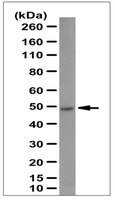PGC-1-related coactivator (PRC), a sensor of metabolic stress, orchestrates a redox-sensitive program of inflammatory gene expression.
Gleyzer, N; Scarpulla, RC
The Journal of biological chemistry
286
39715-25
2011
Show Abstract
PGC-1-related coactivator (PRC) is a growth-regulated transcriptional cofactor that activates many nuclear genes specifying mitochondrial respiratory function. Stable PRC silencing in U2OS cells results in a complex phenotype typical of mitochondrial dysfunction including abundant abnormal mitochondria, reduced respiratory subunit expression, diminished respiratory enzymes and ATP levels, and elevated lactate production. The PRC response to metabolic stress was investigated by subjecting cells to metabolic insults including treatment with the uncoupler carbonyl cyanide 3-chlorophenylhydrazone (CCCP), expression of a dominant negative allele of nuclear respiratory factor 1 (NRF-1), and glucose deprivation. These treatments led to constitutively elevated PRC protein levels, a departure from its normal transient expression upon the initiation of cell growth. A microarray screen identified 45 genes that require PRC for their induction by CCCP. A subset of these genes specific to inflammation and cell stress was also induced by dominant negative NRF-1 and by glucose deprivation, suggesting that diverse metabolic insults converge on the same PRC-dependent inflammatory program. The PRC-dependent inflammatory response was inhibited by N-acetylcysteine, suggesting that PRC may contribute to the inflammatory microenvironment linked to oxidant signaling. The induction of this PRC-dependent program may be an early event in adaptations linked to cancer and degenerative diseases. | 21937425
 |
PGC-1-related coactivator complexes with HCF-1 and NRF-2beta in mediating NRF-2(GABP)-dependent respiratory gene expression.
Vercauteren, K; Gleyzer, N; Scarpulla, RC
The Journal of biological chemistry
283
12102-11
2008
Show Abstract
The PGC-1 family of regulated coactivators (PGC-1alpha, PGC-1beta, and PRC) plays an important role in directing respiratory gene expression in response to environmental signals. Here, we show that PRC and PGC-1alpha differ in their interactions with nuclear hormone receptors but are highly similar in their direct binding to several nuclear transcription factors implicated in the expression of the respiratory chain. Surprisingly, neither coactivator binds NRF-2(GABP), a multisubunit transcriptional activator associated with the expression of many respiratory genes. However, the NRF-2 subunits and PRC are co-immunoprecipitated from cell extracts indicating that the two proteins exist in a complex in vivo. Several lines of evidence indicate that HCF-1 (host cell factor 1), a major chromatin component, mediates the association between PRC and NRF-2. Both PRC and NRF-2beta bind HCF-1 in vitro, and the molecular determinants required for the interactions of each with HCF-1 are also required for PRC trans-activation through promoter-bound NRF-2. These determinants include a consensus HCF-1 binding site on PRC and the NRF-2 activation domain. In addition, PRC and NRF-2beta can complex with HCF-1 in vivo, and all three associate with NRF-2-dependent nuclear genes that direct the expression of the mitochondrial transcription factors, TFB1M and TFB2M. Finally, short hairpin RNA-mediated knock down of PRC protein levels leads to reduced expression of TFB2M mRNA and mitochondrial transcripts for cytochrome oxidase II (COXII) and cytochrome b. These changes in gene expression coincide with a marked reduction in cytochrome oxidase activity. The results are consistent with a pathway whereby PRC regulates NRF-2-dependent genes through a multiprotein complex involving HCF-1. | 18343819
 |









